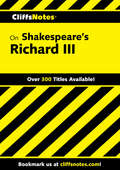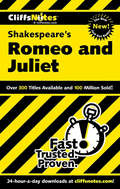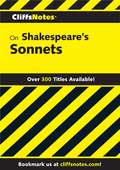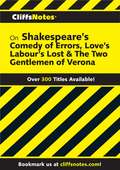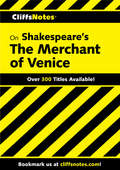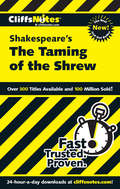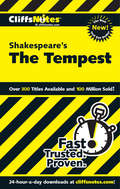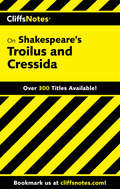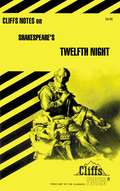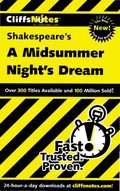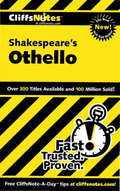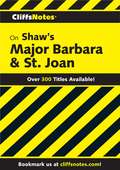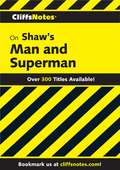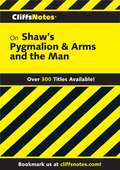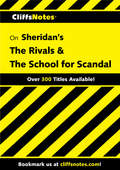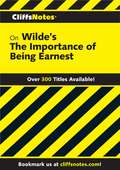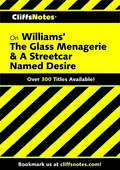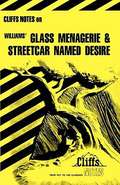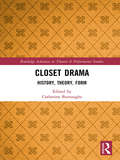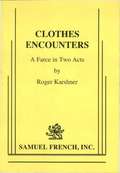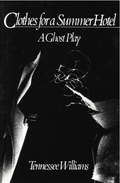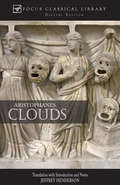- Table View
- List View
CliffsNotes on Shakespeare's Richard III
by James K LowersThis CliffsNotes guide includes everything you've come to expect from the trusted experts at CliffsNotes, including analysis of the most widely read literary works. Richard of Gloucester crosses and double-crosses friends and foes alike in a no-holds-barred effort to solidify control of the throne once occupied by his brother, Edward IV. His antics prove fruitful until one final battle with Henry, Earl of Richmond, at the end of the War of the Roses.
CliffsNotes on Shakespeare's Romeo and Juliet
by Annaliese F. ConnollyThe original CliffsNotes study guides offer expert commentary on major themes, plots, characters, literary devices, and historical background. The latest generation of titles in this series also feature glossaries and visual elements that complement the classic, familiar format.In CliffsNotes on Shakespeare's Romeo and Juliet, you explore Shakespeare's greatest tragedy -- the heartbreaking love story of Romeo and Juliet amid the conflict between their two feuding families, the Montagues and the Capulets.This study guide carefully walks you through every twist and turn of Shakespeare's classic by providing chapter summaries and critical analyses of each act and scene of the play. You'll also explore the life and background of the "Bard" himself -- William Shakespeare. Other features that help you study include: Character analyses of major players, A character map that graphically illustrates the relationships among the characters, Critical essays, The history of the play's development, as well as its first performance, A review section that tests your knowledge, A Resource Center full of books, articles, films, and Internet sites, Classic literature or modern modern-day treasure -- you'll understand it all with expert information and insight from CliffsNotes study guides.
CliffsNotes on Shakespeare's Sonnets
by Carl SennaNumbering more than 150, Shakespeare's sonnets have contributed significantly to discussions of the elusive character of the Bard. While most of the poems are addressed to a young man, others invoke the renowned Dark Lady. Each sonnet is interpreted, focusing on language particular to the poem, as well as on how the sonnet form furthers meaning. In addition, Shakespeare's major themes of love and beauty; mutability; and time and immortality are explored.
CliffsNotes on Shakespeare's The Comedy of Errors, Love's Labour's Lost & The Two Gentlemen of Verona
by Denis M. CalandraThis CliffsNotes guide includes everything you've come to expect from the trusted experts at CliffsNotes, including analysis of the most widely read literary works.
CliffsNotes on Shakespeare's The Merchant of Venice
by Waldo F McneirThe original CliffsNotes study guides offer expert commentary on major themes, plots, characters, literary devices, and historical background.In CliffsNotes on The Merchant of Venice, you follow along as a young merchant cannot repay his debt to a vindictive moneylender.This is the story that introduces us to Shylock, one of the most vivid and memorable characters in Shakespeare's work. You'll gain insight into this romantic comedy as you move through each of the play's five acts. Other features that help you figure out this important work includeLife and background of the authorAnalyses of the charactersA brief synopsis of the playA review section that tests your knowledgeA selected bibliography that leads you to more great resourcesClassic literature or modern-day treasure — you'll understand it all with expert information and insight from CliffsNotes study guides.
CliffsNotes on Shakespeare's The Taming of the Shrew
by Kate MaurerThe original CliffsNotes study guides offer expert commentary on major themes, plots, characters, literary devices, and historical background. The latest generation of titles in this series also feature glossaries and visual elements that complement the classic, familiar format. In CliffsNotes on The Taming of the Shrew, you explore one of Shakespeare's most beloved, and imitated, works. In this play within a play, Petruchio, the man from Verona, marries Kate (the shrew of the story), so that Kate's younger sister Bianca may be allowed to take on several suitors and choose one to marry. Summaries and commentaries lead you, act by act, through this Shakespearean classic, and critical essays give you insight into Shakespeare's historical basis for the play, as well as role playing in The Taming of the Shrew. Other features that help you study include Character analyses of the main characters A character map that graphically illustrates the relationships among the characters A section on the life and background of William Shakespeare A review section that tests your knowledge A ResourceCenter full of books, articles, films, and Internet sites Classic literature or modern modern-day treasure -- you'll understand it all with expert information and insight from CliffsNotes study guides.
CliffsNotes on Shakespeare's The Tempest
by Sheri MetzgerThe original CliffsNotes study guides offer expert commentary on major themes, plots, characters, literary devices, and historical background. The latest generation of titles in this series also feature glossaries and visual elements that complement the classic, familiar format. In CliffsNotes on The Tempest, you follow the famous story of Prospero and his daughter Miranda. Through magic, Prospero conjures up a storm that brings a ship full of his enemies to the island on which he and Miranda live. What follows is Shakespeare's comic masterpiece that's full of intrigue and romance. Summaries and commentaries lead you, act by act, through this Shakespearean classic, and critical essays give you insight into the play as a political romance. Other features that help you study include Character analyses of the main characters A character map that graphically illustrates the relationships among the characters A section on the life and background of William Shakespeare A review section that tests your knowledge A ResourceCenter full of books, articles, films, and Internet sites Classic literature or modern modern-day treasure -- you'll understand it all with expert information and insight from CliffsNotes study guides.
CliffsNotes on Shakespeare's The Tempest
by Sheri MetzgerThe original CliffsNotes study guides offer expert commentary on major themes, plots, characters, literary devices, and historical background. The latest generation of titles in this series also feature glossaries and visual elements that complement the classic, familiar format. In CliffsNotes on The Tempest, you follow the famous story of Prospero and his daughter Miranda. Through magic, Prospero conjures up a storm that brings a ship full of his enemies to the island on which he and Miranda live. What follows is Shakespeare's comic masterpiece that's full of intrigue and romance. Summaries and commentaries lead you, act by act, through this Shakespearean classic, and critical essays give you insight into the play as a political romance. Other features that help you study include Character analyses of the main characters A character map that graphically illustrates the relationships among the characters A section on the life and background of William Shakespeare A review section that tests your knowledge A ResourceCenter full of books, articles, films, and Internet sites Classic literature or modern modern-day treasure -- you'll understand it all with expert information and insight from CliffsNotes study guides.
CliffsNotes on Shakespeare's Troilus and Cressida
by James K LowersThis CliffsNotes guide includes everything you&’ve come to expect from the trusted experts at CliffsNotes, including analysis of the most widely read literary works.
CliffsNotes on Shakespeare's Twelfth Night
by James L RobertsThe original CliffsNotes study guides offer expert commentary on major themes, plots, characters, literary devices, and historical background. The latest generation of titles in this series also feature glossaries and visual elements that complement the classic, familiar format. In CliffsNotes on Twelfth Night, you follow several separate groups of characters whose stories are flawlessly woven together to produce one of Shakespeare's lightest, most popular, and most musical comedies -- full of intricate plots and subplots and witty banter that only Shakespeare could write. Summaries and commentaries take you through Shakespeare's masterpiece, and character analyses of such memorable characters as Viola, Olivia, and Duke Orsino clue you in on their motivations. You also get these additional features: A section on the life and background of William Shakespeare A review section that tests your knowledge A selected bibliography Classic literature or modern modern-day treasure -- you'll understand it all with expert information and insight from CliffsNotes study guides.
CliffsNotes on Shakespeares A Midsummer Nights Dream
by Karin JacobsonThe original CliffsNotes study guides offer a look into critical elements and ideas within classic works of literature.In CliffsNotes on A Midsummer Night's Dream, you dig into Shakespeare's entertaining story of young lovers as they're toyed with by mischievous forest sprites.Shakespeare claimed to have written this romantic comedy to show that "love hath no law but its own." This study guide follows the action from scene to scene with commentaries that bring sense to the entertaining play, which is neither realistic nor tragic. Other features that help you figure out this important work includeLife and background of the authorIntroduction to and synopsis of the playAnalyses of all the characters and a character mapSummaries of each of the five actsA review section that tests your knowledge and suggests essay topicsClassic literature or modern-day treasure -- you'll understand it all with expert information and insight from CliffsNotes study guides.
CliffsNotes on Shakespeares Othello
by Gary K Carey Helen MccullochThe original CliffsNotes study guides offer expert commentary on major themes, plots, characters, literary devices, and historical background. The latest generation of titles in the series also feature glossaries and visual elements that complement the classic, familiar format. Betrayal and manipulation lie at the heart of Othello. Keep up with all the crosses and double-crosses of this tragic play with the CliffsNotes version of the play, which will help you form your own opinions about Iago's schemes, Othello's motives, and Desdemona's loyalty. Other features that help you study include Background information about the life and times of William Shakespeare to help you understand his influences A character map that graphically illustrates the relationships among the characters Glossaries to help you comprehend Shakespeare's language Critical essays on the character pairs and major themes of the play A review section that tests your knowledge Classic literature or modern modern-day treasure--you'll understand it all with expert information and insight from CliffsNotes study guides.
CliffsNotes on Shaw's Major Barbara & St. Joan
by Jeffrey FisherThis CliffsNotes guide includes everything you’ve come to expect from the trusted experts at CliffsNotes, including analysis of the most widely read literary works.
CliffsNotes on Shaw's Man & Superman
by James K LowersThis CliffsNotes guide includes everything you’ve come to expect from the trusted experts at CliffsNotes, including analysis of the most widely read literary works.
CliffsNotes on Shaw's Pygmalion & Arms and the Man
by James K Lowers Marilynn O HarperIn Pygmalion, Shaw presents the classical story of a professor who transforms a girl of the lower class into an elegant creature, who then falls in love with him—unfortunately in love, that is. Set in Bulgaria, Arms and the Man satirizes romantic attitudes about love and war. Raina, the heroine, falls in love with a cowardly, chocolate-loving enemy soldier during an unnamed war. After the war, her fiance challenges her new admirer to a duel, loses heart, and proposes to the maid instead.
CliffsNotes on Sheridan's The Rivals & The School for Scandal
by A. M. FiskinThis CliffsNotes guide includes everything you’ve come to expect from the trusted experts at CliffsNotes, including analysis of the most widely read literary works.
CliffsNotes on Wilde's The Importance of Being Earnest
by Susan Van KirkThe original CliffsNotes study guides offer a look into critical elements and ideas within classic works of literature. The latest generation of titles in this series also feature glossaries and visual elements that complement the classic, familiar format. CliffsNotes on The Importance of Being Earnest offers a concise look at this Victorian farce, which tweaks the complacency and aristocratic attitudes prevalent among the wealthy upper class of the time. Hidden identities, fierce repartee, underlying passions, and surprises punctuate this lively play. This study guide shows, through its expert commentaries, just how three sets of lovers clear up mishap and misunderstandings and end up happily ever after. Other features that help you figure out this survey of Victorian social issues include:A close look at the author's life, which itself was rife with scandal and ruinSummaries and commentaries, act by actDescriptive character analysesA character map that reveal key relationshipsCritical essays on Victorian views on compassion, religion, marriage, and moreA review section that tests your knowledge, and suggested essay topics Classic literature or modern-day treasure—you'll understand it all with expert information and insight from CliffsNotes study guides.
CliffsNotes on Wilder's Our Town
by Gary K CareyThis CliffsNotes guide includes everything you’ve come to expect from the trusted experts at CliffsNotes, including analysis of the most widely read literary works.
CliffsNotes on Williams' The Glass Menagerie & A Streetcar Named Desire
by James L RobertsThe original CliffsNotes study guides offer a look into key elements and ideas within classic works of literature.CliffsNotes on Glass Menagerie & Streetcar Named Desire explores two popular plays, both of which take place in the South and borrow heavily from author Tennessee Williams's own life experiences.Following stories marked by struggle among loved ones, this study guide provides summaries and critical commentaries for each scene within the works. Other features that help you figure out this important work includePersonal background on the playwrightIntroduction to and synopsis of the playsIn-depth analyses of the cast of charactersReview section that features interactive quizzes and suggested essay topicsSelected bibliographies for both playsClassic literature or modern-day treasure -- you'll understand it all with expert information and insight from CliffsNotes study guides.
CliffsNotes on Williams' The Glass Menagerie and A Streetcar Named Desire
by James L. RobertsThe original CliffsNotes study guides offer a look into key elements and ideas within classic works of literature. CliffsNotes on Glass Menagerie & Streetcar Named Desire explores two popular plays, both of which take place in the South and borrow heavily from author Tennessee Williams's own life experiences. Following stories marked by struggle among loved ones, this study guide provides summaries and critical commentaries for each scene within the works. Other features that help you figure out this important work include Personal background on the playwright Introduction to and synopsis of the plays In-depth analyses of the cast of characters Review section that features interactive quizzes and suggested essay topics Selected bibliographies for both playsClassic literature or modern-day treasure - you'll understand it all with expert information and insight from CliffsNotes study guides.
Closet Drama: History, Theory, Form (Routledge Advances in Theatre & Performance Studies)
by Catherine BurroughsCloset Drama: History, Theory, Form introduces the emerging field of Closet Drama Studies by featuring twelve original essays from distinguished scholars who offer fresh and illuminating perspectives on closet drama as a genre. Examining an unusual mix of historical narratives, performances, and texts from the Renaissance to the present, this collection unleashes a provocative array of theoretical concerns about the phenomenon of the closet play—a dramatic text written for reading rather than acting.
Clothes Encounters
by Roger KarshnerFarce / 3m, 2f / Interior When Alan Masters, a real estate broker, shows a property to Betty Parker, she is inadvertently soaked by a misdirected shower requiring her to disrobe. Unbeknownst to Alan, his wife, Kathy, also a broker, arrives to show the property to Betty's husband, Ralph, who also falls victim to the goofy shower. Betty and Ralph, scantily clad in the homeowners' clothing, must be kept out of each other's way by the artful, ridiculous machinations of Alan and Kathy. The farce is a mixture of double meanings, mistaken identities and sexual innuendo whose plot is further intensified by the presence of Heinz, a well-meaning but bumbling handyman. The situation is a riotous whirlwind that resolves itself to the satisfaction of all.
Clothes for a Summer Hotel
by Tennessee WilliamsThe late Tennessee Williams's Clothes for a Summer Hotelmade its New York debut in 1980. Here Scott and Zelda Fitzgerald, often seen as symbols of the doomed youth of the jazz age, become two halves of a single creative psyche, each part alternately feeding and then devouring the other. Set in Highland Hospital near Asheville, North Carolina, where Zelda spent her last confinement, this "ghost play" begins several years after Scott's death of a heart attack in California. But the past is "still always present" in Zelda, and Williams's constant shifting of chronology and mixing of remembrance with ghostly re-enactment suggest that our real intimacy is with the shadow characters of our own minds. As Williams said in the Author's Note to the Broadway production: "Our reason for taking extraordinary license with time and place is that in an asylum and on its grounds liberties of this kind are quite prevalent: and also these liberties allow us to explore in more depth what we believe is truth of character. " Williams poses the inevitable, unanswerable questions: Did Scott prevent Zelda from achieving an independent creativity? Did Zelda's demands force Scott to squander his talents and turn to alcohol? Whose betrayal--emotional, creative, sexual--destroyed the other? But he poses these questions in a new way: in the act of creation, Zelda and Scott are now aware of their eventual destruction, and the creative fire that consumed two artists combines symbolically with the fire that ended Zelda's life.
Clothes for a Summer Hotel: Play
by Tennessee WilliamsThis late play by Tennessee Williams explores the troubled relationship between F. Scott and Zelda Fitzgerald. The late Tennessee Williams's Clothes for a Summer Hotelmade its New York debut in 1980. Here Scott and Zelda Fitzgerald, often seen as symbols of the doomed youth of the jazz age, become two halves of a single creative psyche, each part alternately feeding and then devouring the other. Set in Highland Hospital near Asheville, North Carolina, where Zelda spent her last confinement, this "ghost play" begins several years after Scott's death of a heart attack in California. But the past is "still always present" in Zelda, and Williams's constant shifting of chronology and mixing of remembrance with ghostly re-enactment suggest that our real intimacy is with the shadow characters of our own minds. As Williams said in the Author's Note to the Broadway production: "Our reason for taking extraordinary license with time and place is that in an asylum and on its grounds liberties of this kind are quite prevalent: and also these liberties allow us to explore in more depth what we believe is truth of character." Williams poses the inevitable, unanswerable questions: Did Scott prevent Zelda from achieving an independent creativity? Did Zelda's demands force Scott to squander his talents and turn to alcohol? Whose betrayal--emotional, creative, sexual--destroyed the other? But he poses these questions in a new way: in the act of creation, Zelda and Scott are now aware of their eventual destruction, and the creative fire that consumed two artists combines symbolically with the fire that ended Zelda's life.
Clouds
by Aristophanes Jeffrey HendersonThis is an English translation of Aristophanes' famous comedy, Clouds, noted for its critique of philosophy, society and education. It includes essays on Old Comedy and the Theater of Dionysus, suggestions for further reading, notes on production, and a map. Focus Classical Library provides close translations with notes and essays to provide access to understanding Greek culture.
